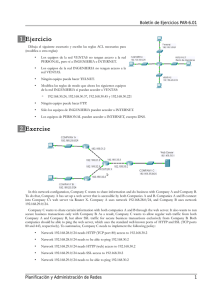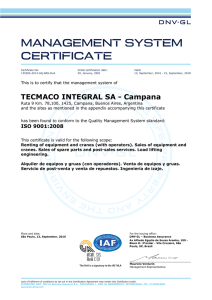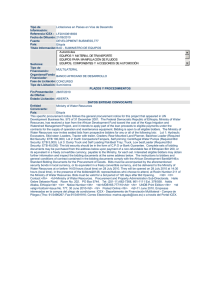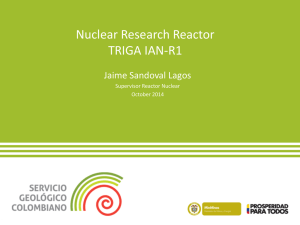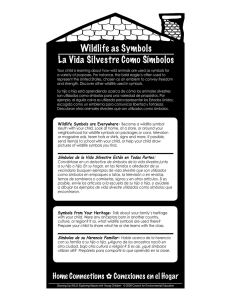Document
Anuncio
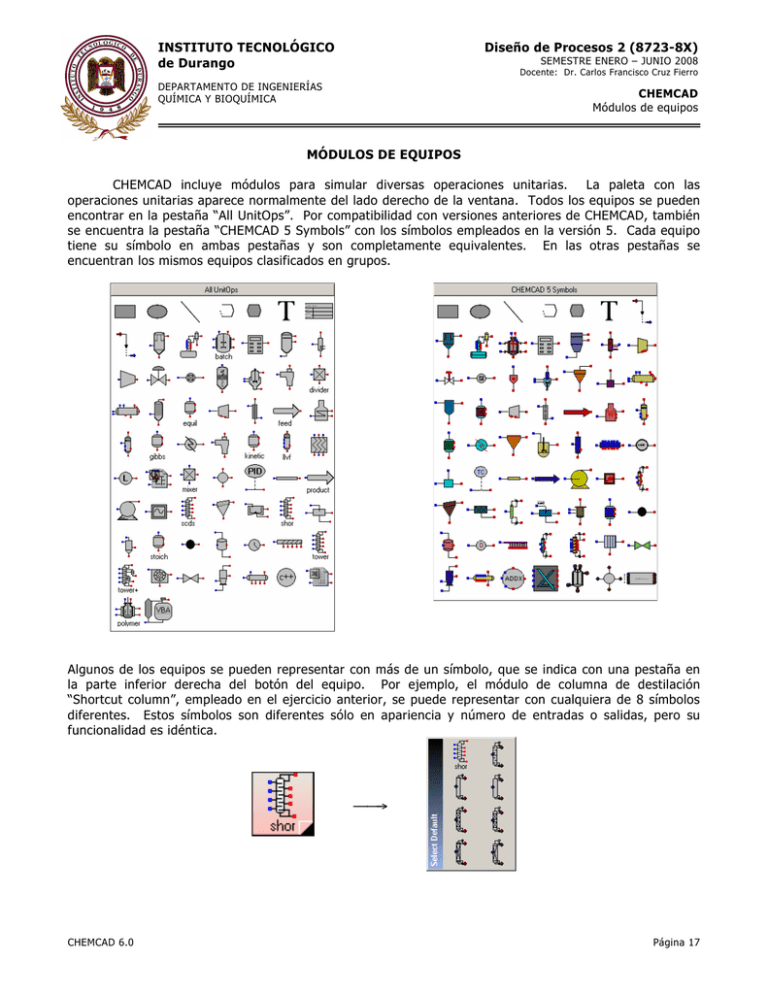
INSTITUTO TECNOLÓGICO de Durango Diseño de Procesos 2 (8723-8X) SEMESTRE ENERO – JUNIO 2008 Docente: Dr. Carlos Francisco Cruz Fierro DEPARTAMENTO DE INGENIERÍAS QUÍMICA Y BIOQUÍMICA CHEMCAD Módulos de equipos MÓDULOS DE EQUIPOS CHEMCAD incluye módulos para simular diversas operaciones unitarias. La paleta con las operaciones unitarias aparece normalmente del lado derecho de la ventana. Todos los equipos se pueden encontrar en la pestaña “All UnitOps”. Por compatibilidad con versiones anteriores de CHEMCAD, también se encuentra la pestaña “CHEMCAD 5 Symbols” con los símbolos empleados en la versión 5. Cada equipo tiene su símbolo en ambas pestañas y son completamente equivalentes. En las otras pestañas se encuentran los mismos equipos clasificados en grupos. Algunos de los equipos se pueden representar con más de un símbolo, que se indica con una pestaña en la parte inferior derecha del botón del equipo. Por ejemplo, el módulo de columna de destilación “Shortcut column”, empleado en el ejercicio anterior, se puede representar con cualquiera de 8 símbolos diferentes. Estos símbolos son diferentes sólo en apariencia y número de entradas o salidas, pero su funcionalidad es idéntica. → CHEMCAD 6.0 Página 17 INSTITUTO TECNOLÓGICO de Durango DEPARTAMENTO DE INGENIERÍAS QUÍMICA Y BIOQUÍMICA Diseño de Procesos 2 (8723-8X) SEMESTRE ENERO – JUNIO 2008 Docente: Dr. Carlos Francisco Cruz Fierro CHEMCAD Módulos de equipos Las descripciones siguientes cubren solamente la paleta de símbolos de CHEMCAD 6. Para una lista de los símbolos de CHEMCAD 5 consultar: http://tecno.cruzfierro.com/cursos/2007a/procesos2/cc02-equipos.pdf Los primeros símbolos de la paleta no representan equipos sino que se emplean únicamente para dibujar elementos simples, generalmente para complementar el diagrama de flujo del proceso con anotaciones. El siguiente símbolo, que se usó en el ejercicio anterior, se emplea para conectar los diferentes equipos, es decir, para dibujar las corrientes del proceso. Los demás símbolos se listan a continuación, junto con la descripción tomada del archivo de ayuda. ICON DESCRIPTION BAGHOUSE FILTER The BAGH module simulates or rates the operation of a standard fabric filter dust collector. The module calculates the collection efficiency and pressure drop or flow through the dust bed and fabric. BATCH COLUMN Simulates a batch distillation column, for which there is a series of more or less independent operation steps. BATCH REACTOR Simulates batch, semibatch and continuous operation of reactors with an unlimited number of simultaneous reactions, with any combination of jackets, external coils, and/or internal coils in the reactor vessel. CALCULATOR The calculator unit operation is used to program user specified unit operations. The calculator UnitOp allows the use of a C parser file. The user must write a parser file and customize the calculator dialog screen. CENTRIFUGE The CFUG module will design or simulate the average behavior of basket centrifugal filters. These machines may be batch or semi-batch, depending on solids loading. With the exceptions of machine geometry and centrifugal acceleration considerations, the treatment is similar to most other filters. The module accounts for cake and filter medium resistance and cake compressibility. COMPONENT SEPARATOR The component separator serves as a black-box separator which splits an input stream into two output streams of different compositions and thermal conditions. By specifying split fraction or split flow rate component by component, almost any kind of separation can be performed. CHEMCAD 6.0 Página 18 INSTITUTO TECNOLÓGICO de Durango Diseño de Procesos 2 (8723-8X) SEMESTRE ENERO – JUNIO 2008 Docente: Dr. Carlos Francisco Cruz Fierro DEPARTAMENTO DE INGENIERÍAS QUÍMICA Y BIOQUÍMICA ICON CHEMCAD Módulos de equipos DESCRIPTION COMPRESSOR The COMPRESSOR module simulates an isentropic or polytropic compressor operation. CONTROL VALVE The control valve calculates the flowrate through the valve based on the output signal it receives from a controller. Each control valve, therefore, must have a designated controller ID as part of its input. The module can handle compressible and incompressible flow as well as critical and sub-critical flow. CONTROLLER The controller (CONT) UnitOp is a numerical controller. It behaves similar to a solver routine. It is placed in the flowsheet between other unit operation modules and it can be a feed forward or feedback controller. CRUSHER GRINDER The CRSH module calculates the work requirement and size reduction for three different types of crushers. CRYSTALLIZER The CRYS module can be used to simulate crystallization or melting processes by cooling or heating. It can also be used as a dissolver where a second solvent stream is added to maintain the outlet stream at a desired concentration level. CYCLONE The CYCL module will simulate or rate a gas-solid cyclone separator. DIVIDER The divider splits an input stream into several output streams of the same composition and intensive properties. Splits based on the flow ratio or flowrate can be specified. DYNAMIC VESSEL The dynamic vessel unit operations module is a dynamic phase separator and/or accumulator. It is basically a dynamic flash tank with holdups. ELECTRO PRECIPITATOR The ESPT module will simulate or design an electrostatic precipitator. Electrostatic precipitators use charged plates to energize and collect small dust particles from gas streams. EQUILIBRIUM REACTOR The EQUILIBRIUM REACTOR model gives the user the capability to simulate reactors with multiple reactions defined by conversion or equilibrium ratios. Product rates, compositions, and thermal conditions may be calculated by solving the reactor equilibrium equation along with the mass and energy balances. EXPANDER The EXPANDER module simulates an isentropic or polytropic expander operation. LIQUID-LIQUID EXTRACTOR The LIQUID/LIQUID EXTRACTION module calculates the heat and material balance of a stagewise contacting of two immiscible liquid mixtures. CHEMCAD 6.0 Página 19 INSTITUTO TECNOLÓGICO de Durango DEPARTAMENTO DE INGENIERÍAS QUÍMICA Y BIOQUÍMICA ICON Diseño de Procesos 2 (8723-8X) SEMESTRE ENERO – JUNIO 2008 Docente: Dr. Carlos Francisco Cruz Fierro CHEMCAD Módulos de equipos DESCRIPTION FEED Dummy unit operation for indicating feed streams. The data of the feed stream is not defined on this symbol itself, but on the stream connecting this symbol with the next unit operation. FIRED HEATER The fired heater calculates the fuel usage required to heat a process stream to a specified temperature. FLASH The FLASH unit is a general flash model which allows various flash operations. Flash calculations including isothermal, adiabatic, isentropic, vapor fraction under different temperature and pressure conditions can be performed. GIBBS REACTOR The GIBBS reactor model may be used to simulate reactors for the purpose of heat and material balances. Product rates, compositions, and thermal conditions are calculated by the minimization of Gibbs free energy, subject to an overall mass balance. All components in the component list (for the current flowsheet) are considered in the Gibbs free energy minimization calculation unless specifically excluded (identified as inert). HEAT EXCHANGER The heat exchanger module can be used to simulate an exchanger with one or two input streams. For one input stream, the exchanger serves as a heater or a cooler. If the exchanger has two input streams, more complicated operational modes are available. HYDROCYCLONE The HCYC module will simulate or design a hydrocyclone to separate solids in a liquid stream. Hydrocyclones use internally-generated centrifugal force to separate particles into small and large size groups. KINETIC REACTOR The KINETIC REACTOR model gives the user the capability of rating or designing plug flow (PFR) and continuous stirred tank reactors (CSTR). Up to 20 simultaneous reactions are permitted. In the Design mode, the user specifies the required fractional conversion of a key component and Chemcad calculates the required volume of the reactor. The Rating mode allows the user to specify the available volume, and Chemcad calculates the outlet composition and conditions. Either reactor (PFR or CSTR) may be applied to the liquid or vapor phase. Mixed phase reactors are allowed, but the reactions take place in only one phase. LIQUID-LIQUID-VAPOR FLASH The three phase flash module simulates a rigorous vapor/liquid/liquid calculation. It requires three output streams when this module is selected regardless of whether three phases (VLL) will be formed or not. The first output is for vapor phase. The second output contains liquid of the less dense phase, while the third output contains liquid of the more dense phase which usually is the water phase if water is present as one of the components. LNG HEAT EXCHANGER (MULTI-STREAM EXCHANGER) The LNG heat exchanger is used to simulate the exchange of heat between multiple hot and cold streams. The total number of hot and cold input streams is limited to seven. LOOP The Loop module is used to force CHEMCAD into executing a given sequence of unit operations until a convergence tolerance is reached. Using this module, it is possible to run a large simulation with an easy convergence tolerance, and at the same time run a small subset of the flowsheet at a tighter convergence tolerance. The loop unit is a convenient way to track the convergence tolerances and the execution order of a flowsheet. CHEMCAD 6.0 Página 20 INSTITUTO TECNOLÓGICO de Durango Diseño de Procesos 2 (8723-8X) DEPARTAMENTO DE INGENIERÍAS QUÍMICA Y BIOQUÍMICA ICON SEMESTRE ENERO – JUNIO 2008 Docente: Dr. Carlos Francisco Cruz Fierro CHEMCAD Módulos de equipos DESCRIPTION META (EXTERNAL FLOWSHEET LINK) Used to perform calculations in another CHEMCAD flowsheet, as a subset of the current flowsheet. MIXER The mixer module mixes several input streams and performs an adiabatic flash calculation at the output pressure of the mixer. If more than one output stream is entered, the mixer also serves as a phase separator (see the FLASH section). NODE Used to specify or calculate the pressure at a given point in the flowsheet. PID CONTROLLER The PID Controller continuously measures the user specified variable, and based upon the specified setpoint for that variable, sends a controller output signal (in milliamps) to the control valve. The controller can include proportional, derivative, and/or integral action in its signal computation. Cascade controllers are permitted. The user may specify the control loop and controller limits if so desired. Also, the controller time step may be set to a smaller value than the flowsheet integration time step. The controller is actually a sensor and controller, i.e., it measures its own input as well as calculating its output. PIPE SIMULATOR The PIPE module calculates the size of a particular segment of pipe or the pressure drop through that segment. PRODUCT Dummy unit operation for indicating product streams. PUMP The liquid pump module is used to increase the pressure of a liquid stream. RAMP CONTROL The Ramp controller unit is used to change various operating parameters with respect to time. In dynamic simulations, the scheduling ramp may be used to simulate operator functions such as opening a valve at time = t. SCDS COLUMN SCDS (Rigorous Simultaneous Correction Distillation) is a rigorous multi-stage vapor-liquid equilibrium module which simulates any single column calculation including distillation columns, absorbers, reboiled absorbers and strippers. Side products and side heaters/coolers can also be modeled rigorously by SCDS. Murphree tray efficiency can also be input and simulated by SCDS. SCDS handles columns with unlimited stages, five feed streams, and four side products. SCREEN The SCRE module will simulate a screening process by either a separation formula or an efficiency table. SEDIMENTATOR (Centrifugal Sedimentator) The CSED module will model the case describing the average behavior of a solid-wall basket centrifuge separating solids from a liquid slurry. The solids must be more dense than the liquid. CHEMCAD 6.0 Página 21 INSTITUTO TECNOLÓGICO de Durango DEPARTAMENTO DE INGENIERÍAS QUÍMICA Y BIOQUÍMICA ICON Diseño de Procesos 2 (8723-8X) SEMESTRE ENERO – JUNIO 2008 Docente: Dr. Carlos Francisco Cruz Fierro CHEMCAD Módulos de equipos DESCRIPTION SHORTCUT COLUMN The shortcut distillation module uses the Fenske-Underwood-Gilliland method to simulate a simple distillation column with one input stream and two product streams (distillate and bottom). Both rating and design cases are provided. The feed location can be calculated by the Fenske or Kirkbride equations. A case study option is also provided to allow you to vary R/Rmin in the specified ranges and review its effects on column performance. Note that shortcut distillation methods may not be suitable for column design and may give incorrect results in systems with azeotropes. It is reccomended that you use a rigorous distillation method such as Tower Plus, Tower, or SCDS to confirm any shortcut results. SOLID WASHER The WASH module simulates the mass and energy balances associated with a washing process. The user specifies energy and washing parameters. SOLID DRYER The DRYR module will simulate the material and energy balances associated with a general drying process. STOICHIOMETRIC REACTOR The stoichiometric reactor module simulates one reaction, for a given set of stoichiometric factors, key component and fraction of conversion. The reactor can be adiabatic, isothermal, or have a specified heat duty. STREAM REFERENCE The stream transfer module can be used to transfer process stream information to another process stream. Tower plus/distillation internal streams and pumparound streams can also be transferred to simulate heat integrated process systems. This module serves as an abstract block in the flowsheet, and its output stream is exactly the same as its input stream. TANK The TANK unitop is for Batch Distillation only. For a steady state simulation, use a FLASH or VESSEL unit to represent a storage tank. Also, use the Vessel Sizing tool on the Sizing menu. For dynamic models, consider using the Dynamic Vessel UnitOp. TIME DELAY The Time Delay unit is used to simulate delays in dynamic simulation, such as pipe delays. TIME SWITCH The Time Switch UnitOp is a process flow traffic cop. It provides a time schedule for the direction of the inlet flow flows towards multiple outlets. TOWER TOWR is a rigorous multi-stage vapor-liquid equilibrium module which simulates any single column calculation including distillation columns, absorbers, reboiled absorbers and strippers. Side products and side heaters/coolers can also be modeled rigorously by TOWR. TOWR handles columns with a maximum of five feed streams, and four side products. TOWER PLUS TOWER PLUS is a rigorous tower module which simulates towers with side strippers, pumparounds, side heaters/coolers, and side product. It is designed for tower simulations, but it can also be used to simulate any single column calculation including distillation columns, absorbers, reboiled absorbers and strippers. Side strippers, pumparounds are all treated as part of the TOWER PLUS module and are solved simultaneously with the main column without going through the recycle calculation. Free water can be decanted from the condenser as well as from any trays specified by the user. CHEMCAD 6.0 Página 22 INSTITUTO TECNOLÓGICO de Durango Diseño de Procesos 2 (8723-8X) SEMESTRE ENERO – JUNIO 2008 Docente: Dr. Carlos Francisco Cruz Fierro DEPARTAMENTO DE INGENIERÍAS QUÍMICA Y BIOQUÍMICA ICON CHEMCAD Módulos de equipos DESCRIPTION VACUUM FILTER The FLTR module will simulate or design either a vacuum or a constant-pressure filter. VALVE The valve UnitOp is used to specify a pressure drop on a stream. Output pressure, pressure drop, dew point temperature or bubble point temperature can be specified. The valve UnitOp will serve as a phase separator if more than one output stream is specified. VENTURI SCRUBBER The VSCR module will simulate or design a venturi scrubber. Venturi scrubbers are used to precipitate particulates, fogs and condensible vapors from gas streams. VSCR will partition the particulates between the liquid and vapor outlet streams but treats the liquid-vapor contact as an equilibrium system. VESSEL The vessel unit is used whenever you wish to combine the use of a flash drum with a divider. This unit allows you to separate a vapor phase from the liquid, and you may split the liquid between several outlets. USER ADDED MODULE It allows the use of an user-defined unit operation. EXCEL UNIT With the “Excel” unit, CHEMCAD 5 is now capable of linking its flowsheet with Excel workbooks as its unit operations. When placing an Excel Unit icon on a flowsheet, specifying the path to an Excel workbook, and running the flowsheet, CHEMCAD can activate the specified Excel workbook and execute the given VBA macros of the workbook. POLYMER REACTOR Reactor module for the specific purpose of modelling polymerization reactions. VISUAL BASIC UNITOP It allows the use of a VB module to perform user-defined calculations. CHEMCAD 6.0 Página 23
